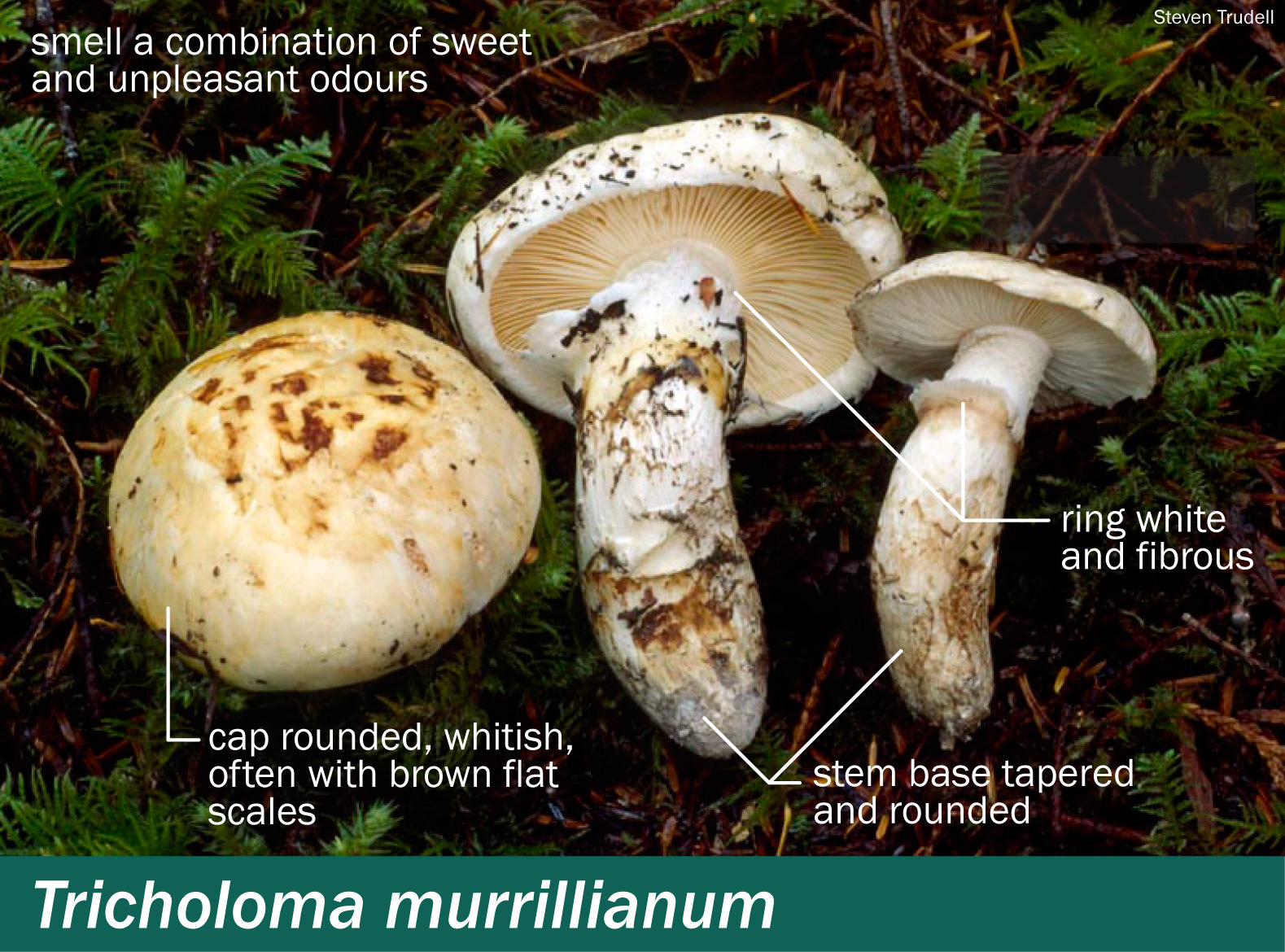Tricholoma murrillianum — Western pine mushroom, western matsutake
Edible
Prized for its spicy, cinnamon or cedar odour and distinctive flavour.
Gills: attached or notched near stem
Spore print: white
Warning: Before eating any, make sure that each and every mushroom is really a matsutake and not Amanita smithiana, Smith's amanita. Both species make medium to large white mushrooms and they commonly grow together.
- In the typical pine mushroom, the stem is widest near the gills or ring, and narrows below ground toward the base. In contrast, the stem of Smith's amanita widens at ground level or even below ground to a torpedo-shaped bulb.
- Try the stem break test: Can you break or remove the stem by holding it firmly and rocking it from side to side? Pine mushroom stems are solid and firmly attached to both the gills and the cap and you would have to mangle the mushroom to remove the stem. In Smith's amanita, the stem will usually break off if wiggled back and forth, sometimes coming cleanly off in one piece and leaving a round depression under the cap.
Odour: Spicy, cinnamon red hots and dirty gym socks2
Cap: 6–20 cm in diameter, when young convex with an inrolled margin, flattening as they expand with age. Surface dry, white or whitish, with flattened fibres or with small, flat, yellowish or brownish scales.
Gills: White or cream-coloured, close, at least narrowly attached to the top of the stem. The gills are initially covered by a cottony veil that breaks free from the edge of the expanding cap. The veil remains attached to the stem as a ring.
Flesh: Firm and dense, rubbery.
Stems: 5–15 cm long, 1.5–4.5 cm wide with a membranous ring. Between ring and gills, stems are white. Below the ring, stems are often speckled cinnamon brown on a white background. Stems are usually widest near the cap or at the ring, tapering to a narrow belowground base and rounded at their very tips.
Ring: It flares out at first but with age, it flops down to rest like a ragged skirt against the stalk.
Cup (volva): Not present.
Spores: 4–7 x 3–5 µm, broadly ellipsoid, not amyloid (not changing to blue in Melzer's iodine solution).
Habitat: In duff, in conifer forests of western North America. Associated with pines (Pinus spp.), Douglas fir (Pseudotsuga menziesii), western hemlock (Tsuga heterophylla) and spruce (Picea spp.)7 and the non-photosynthetic epiparasite Allotropa virgata8. Ectomycorrhizal.
Tricholoma caligatum, the brown matsutake is edible though sometimes bitter. Catathelasma species, also edible, are distinguishable by a double ring that may be hard to see9.
Trudell et al.6 showed that the western pine mushroom, Tricholoma murrillianum, is distinct from both the eastern North American T. magnivelare and the Mexican T. mesoamericanum. Earlier, all of these pine mushrooms had usually been identified as T. magnivelare. All are edible and it would be interesting to find out whether one is more delicious than the others.
Treatment: Contact your regional Poison Control Centre if you or someone you know is ill after eating wild mushrooms. Poison Centres provide free, expert medical advice 24 hours a day, seven days a week. If possible, save the mushrooms or some of the leftover food containing the mushrooms to help confirm identification.
Poison Control:
British Columbia: 604-682-5050 or 1-800-567-8911.
United States (WA, OR, ID): 1-800-222-1222.

